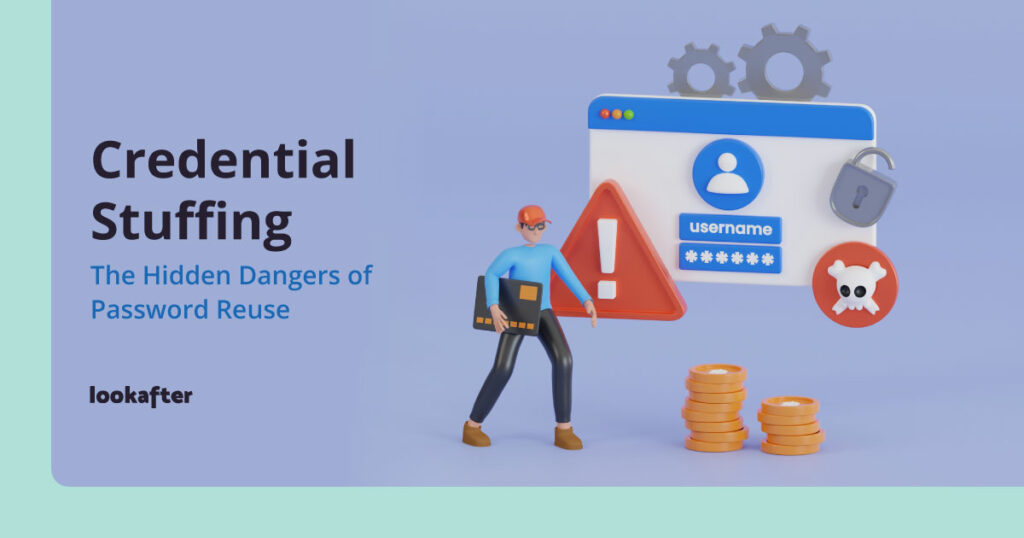Home > Empowering Tips > What is Credential Stuffing: The Hidden Dangers of Password Reuse

Credential stuffing is a type of cyberattack where hackers use stolen usernames and passwords, typically obtained from a data breach, to gain unauthorized access to user accounts on other websites. This attack relies on the fact that many people reuse the same login credentials across multiple platforms.
Here’s a deeper dive into how credential stuffing works and how you can protect yourself.
How Credential Stuffing Works
- Data Breach Acquisition: Attackers obtain stolen login information from data breaches, often through hacking, phishing, or social engineering.
- Credential Lists: These stolen credentials are compiled into lists, which are then automated to target various online services.
- Automated Attacks: Using specialized software, attackers rapidly attempt to log into accounts on different websites using the stolen credentials.
- Account Compromise: If a successful login is achieved, the attacker gains access to the compromised account, potentially leading to identity theft, financial loss, or other harmful consequences.
Why Credential Stuffing Attacks Work So Well
Credential stuffing attacks are surprisingly effective, mainly because they exploit a few key factors related to common weaknesses in user behaviour and website security. Here are the main reasons these attacks are so effective:
- Password Reuse: One of the biggest reasons credential stuffing works is that many users reuse the same username and password across multiple accounts. When one account is compromised in a data breach, attackers can use the stolen credentials to attempt to log into other accounts associated with the same user.
- Automation and Bots: Attackers use automated tools and bots to try thousands, or even millions, of username-password combinations across multiple websites quickly. This automation allows them to test credentials on a large scale with minimal effort, greatly increasing the chances of success.
- Widespread Data Breaches: With the increasing number of data breaches, stolen credentials are easily accessible on the dark web or hacker forums. Hackers can buy large lists of credentials and try them on various platforms, hoping to find matches for active accounts.
- Weak Password Policies: Credential stuffing thrives on weak password choices. Many users still rely on easily guessable passwords like “123456” or “password”. Additionally, some organizations fail to enforce strict password policies, allowing users to create weak passwords or avoid regular password changes.
- Vulnerable Websites: Websites with inadequate security measures, such as outdated software or weak encryption, are more susceptible to credential stuffing attacks. Additionally, sites that do not implement multi-factor authentication, CAPTCHA checks, or rate-limiting for login attempts are especially vulnerable.
- Lack of User Awareness: Many users are unaware of the risks of credential stuffing and continue to use weak or repeated passwords. This lack of awareness makes them vulnerable to having multiple accounts compromised at once, giving attackers more opportunities to succeed.
Consequences of Credential Stuffing
- Account Hijacking: Attackers can take over accounts, lock out legitimate users, and perform unauthorized transactions.
- Financial Losses: Credential stuffing can lead to unauthorized purchases, bank fraud, and theft.
- Identity Theft: With access to personal information stored in user accounts, attackers can use it for more extensive identity theft schemes.
- Reputation Damage: For businesses, a successful credential stuffing attack can harm reputation and trust, especially if customer accounts are compromised.
How to Protect Yourself from Credential Stuffing
- Use Unique Passwords: Always use different passwords for different accounts. This reduces the risk of multiple accounts being compromised in one attack.
- Enable Two-Factor Authentication: This adds an extra layer of security, requiring more than just a password to log in.
- Monitor Accounts for Suspicious Activity: Keep an eye on account activity, and report any unauthorized logins or transactions immediately.
- Use a Password Manager: Password managers can help you generate and store strong, unique passwords for each account.
- Stay Updated: Ensure that you use platforms that regularly update their security protocols to protect against credential stuffing attacks.
By understanding credential stuffing and taking proactive steps to secure your accounts, you can better protect yourself from these increasingly common attacks.